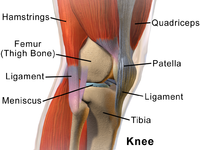
Photo from wikipedia
Purpose To evaluate the current state of knowledge and potential controversies in the treatment of patellofemoral instability among orthopaedic/trauma surgeons in the German-speaking countries. Methods An online survey consisting of… Click to show full abstract
Purpose To evaluate the current state of knowledge and potential controversies in the treatment of patellofemoral instability among orthopaedic/trauma surgeons in the German-speaking countries. Methods An online survey consisting of 32 questions and three fictitious cases was sent to members of the AGA—Society for Arthroscopy and Joint Surgery. Surgeons were defined by our senior authors as high-volume or low-volume surgeons, depending on the number of their cases. The treatment of 25% of patients with patellofemoral instability and/or the performance of 50 patellofemoral instability cases per year distinguishes high- from low-volume surgeons in this study. Results The online questionnaire was completed by 541 experienced knee surgeons from Germany (78%), Austria (10.9%), Switzerland (10.4%) and other countries (0.7%). Most surgeons prefer MPFL reconstruction as surgical intervention in patients with recurrent patellar instability (64–81%). Sixty percent of high-volume surgeons as compared to 21.8% of low-volume surgeons have ever performed a trochleoplasty. Of the overall respondents, 25% would not perform any surgical treatment on adolescents with patellar instability and an open growth plate. Of all responding surgeons, 95% would not treat patellofemoral instability with an isolated lateral release. This corresponds to recent literature showing poor outcome of its strictly isolated application. Conclusion This study provides an overview of the current management of acute and recurrent patellofemoral instability in the German-speaking countries. Results show the surgeons' awareness for highly demanding surgical possibilities for complex patellar instability cases. However, disagreement among surgeons still prevails when it comes to selecting individual multimodal treatment options. This highlights the need for treatment guidelines and algorithms for patellofemoral instability. Level of evidence V.
Journal Title: Knee Surgery, Sports Traumatology, Arthroscopy
Year Published: 2020
Link to full text (if available)
Share on Social Media: Sign Up to like & get
recommendations!